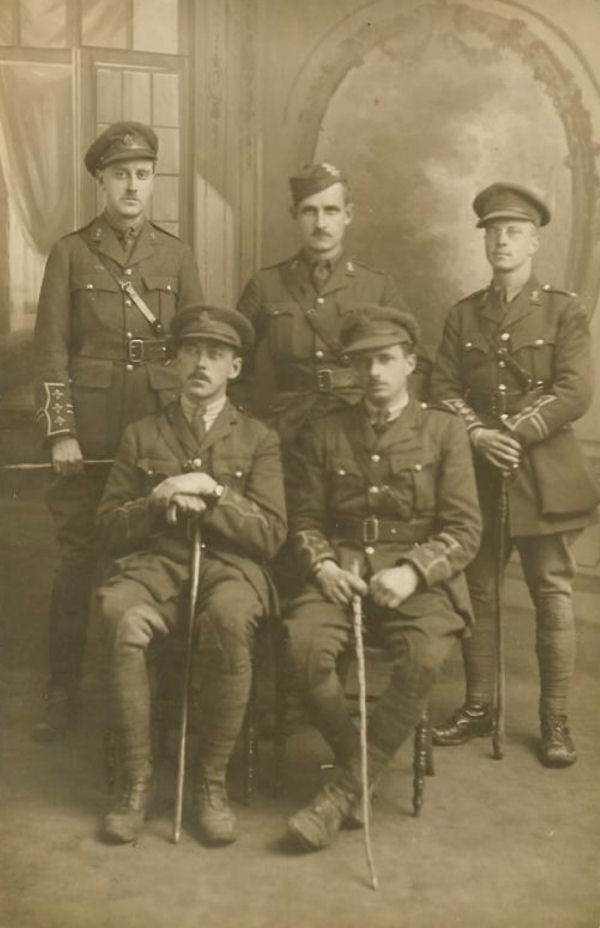Three Awards of the Military Cross
Captain James Ward of the Canadian Field Artillery the only soldier of the CEF to have died in the Great War uniquely earning the Military Cross and 2 Bars, in addition to the Distinguished Conduct Medal. The Military Cross (MC) the second-level military decoration awarded to officers of Commonwealth countries.

The Manor House, Kilsby
James the son William Irvine Ward and Martha Ward, of Manor House, Kilsby, Rugby, England. Born 3 December 1886 in Kilsby, Northamptonshire, England.
Enlistment of Bombardier James Ward
Bombardier James Ward C41722 enlisted 22 September 1914 with the Ammunition Column of the 2nd Brigade, Canadian Field Artillery. Next of kin his mother, now living at The Laurels, Nether Heyford, Weeden, England. He stood 5′ 7″ tall with dark complexion, brown eyes and black hair streaked with grey. One scar right neck.
Gunner James Ward promoted to Sergeant in the Field, 29 May 1915.
Distinguished Conduct Medal

For conspicuous gallantry during the operations. When the Brigade Ammunition Column was forced out of two successive positions by heavy shell and rifle fire, Serjeant Ward maintained communication with the Officer Commanding the Brigade, and his reports were very valuable. He delivered ammunition supplies direct to the infantry in the trenches, although his horse had been shot under him.
London Gazette, 14 January 1916.
Following the award of the DCM, Sergeant James Ward DCM reverts to Corporal at own request, in the field, 13 March 1916.
Corporal James Ward DCM posted to 1st CDAC, and attached to Trench Mortar Battery, 18 April 1916.
1st Canadian Divisional Ammunition Column
1st DAC organized in August 1914 initially under the command of Lieutenant-Colonel J J Penhale. Mobilized at Valcartier, and left Quebec on 30 September 1914 aboard SS MEGANTIC and SS MONTEZUMA. Arrived in England 14 October 1914 with a strength of 30 officers, 561 other ranks. Arrived in France later on 12 February 1915 with the 1st Canadian Divisional Artillery.

1st Canadian Divisional Trench Mortar Group
1st Trench Mortar Group organized at Neuve Eglise, Belgium in March 1916 under the command of Captain C. S. Hanson.
Composed of VIC (Heavy) Battery and XIC, YIC and also ZIC (Medium) Batteries.

Corporal James Ward DCM appointed to a Commission in CFA 7 August 1916, posted to 1st CDAC, and attached to a Trench Mortar Battery.
Promotions
- Ward to be Lieutenant, Canadian Artillery, 30 August 1916.
- Lt James Ward to be Captain while commanding a Company, 26 September 1917.
Military Cross
Lt James Ward DCM awarded the MC, London Gazette, 1 January 1918.

Lieutenant James Ward MC, DCM suffers a GSW to his wrist, slight, 2 September 1918.

Lt James Ward MC, DCM awarded Bar to MC, 2 December 1918.
Military Cross First Bar
For conspicuous gallantry and determination in command of a trench mortar battery during four days’ fighting. This officer controlled three trench mortars throughout the phases of the infantry attack, on more than one occasion placing his mortar in front of the infantry to destroy machine-gun nests and enemy posts.
Throughout he set a fine example of energy and determination.
London Gazette, 15 February 1919
Lt James Ward MC & Bar, DCM awarded 2nd Bar to MC, 15 February 1919. One week later, Ward dangerously ill.
Military Cross Second Bar
For conspicuous gallantry during the Cambrai operations commencing September 27th, 1918, while commanding a battery of six-inch Newton trench mortars.
Throughout the operations he led his battery forward immediately in rear of the advancing infantry, and engaged all the targets pointed out to him. On September 29th he advanced with an infantry battalion and had his mortars in action in the Chateau grounds at Sancourt immediately after the capture of this place. At this time the ‘mopping-up’ was not completed, and his men captured thirty prisoners as they emerged from cellars. From here, in spite of very heavy artillery and machine gun fire, he continued to fire on and destroy machine gun posts, which were causing our men heavy casualties.
London Gazette, 15 February 1919.
From 13 December 1918, to 21 February 1919, Captain James Ward stationed in Cologne, Germany as part of the Allied Occupation of Germany.

Bronchial-Pneumonia
Captain James Ward MC & Two Bar, DCM returned to Namur, Belgium, following the Canadian participation in the Allied Occupation of Germany. The day following his arrival, he fell ill, and was admitted to a Casualty Clearing Station.

Ward dangerously ill, pneumonia, 22 February 1919. He died at No 48 CCS the following day, 23 February 1919.
Belgrade Cemetery
Belgrade Cemetery contains 249 Commonwealth burials of the Great War, most of them dating from the ten months when casualty clearing stations posted to Namur after the Armistice. Also one burial of the Second World War.
The plots of Belgian, Soviet, Italian and French (mainly from 1914) troops are not described by the CWGC. Among the graves of the fallen of different nationalities there are graves of 16 Soviet prisoners of war and members of the Belgian Resistance. The burial was conducted approximately in 1942–1944 and represents a platform of 10×5 meters with the monument erected on it and sixteen gravestones with the names of the fallen.
In 1994, in the central part of the site, a monument erected by sculptor A. Burganov. The granite pedestal reads in Russian and French:
TO THE SOVIET SOLDIERS WHO DIED IN NAMUR. 1941–1945
Ежегодно ветеранская организация г.Льеж, Посольства России в Бельгии и организаций российских соотечественников производят возложения цветов к могилам. Представители Русской православной церкви каждый год проводят панихиду по погибшим.
More
- Blog
- CEFRG on FaceBook
- CEFRG on YouTube
- Soldiers and Nursing Sisters
- Units (Brigades, Battalions, Companies)
- War Diary of the 18th Battalion (Blog)
- 116th Battalion CEF – The Great War
- Les Soldats du Québec Morts en Service
- Montreal Aviation Museum
- Battles of the Great War
- Cases
- Cemeteries
- Memorials
- On This Day
- About CEFRG
